New stadiums: Six giants from China
source: StadiumDB.com; author: StadiumDB.com team
 This is only the very first portion of new Chinese stadiums. Throughout the enormous country new, sometimes beautiful stadiums are popping up and we’ll be showing more! For now it’s these six, one of which will be nominated to become Stadium of the Year 2013!
This is only the very first portion of new Chinese stadiums. Throughout the enormous country new, sometimes beautiful stadiums are popping up and we’ll be showing more! For now it’s these six, one of which will be nominated to become Stadium of the Year 2013!
Advertisement
Shanxi Sports Center Stadium
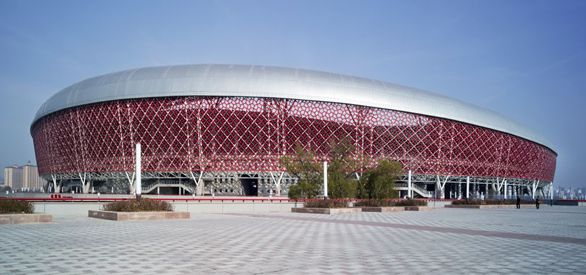
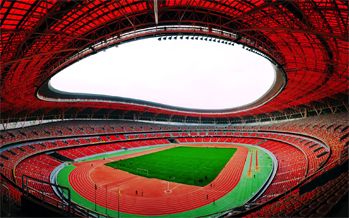 Northern city of Taiyuan may not be among the biggest or most prosperous, but with governmental help it received a new international-standard sport hub. The complex was created on 82 hectares in a new southern district of the city.
Northern city of Taiyuan may not be among the biggest or most prosperous, but with governmental help it received a new international-standard sport hub. The complex was created on 82 hectares in a new southern district of the city.
Design was created in 2007 and filled the area with red and white (actually grayish) ‘ribbon’ shapes. These two colours chase one-another on the exterior of both the central 62,000-capacity stadium and secondary arenas for various disciplines.
The main stadium, according to its creators, is shaped to mimic a traditional Chinese saddle. The exterior was divided into three zones. First from pedestrian’s perspective is the perforated red web, shading, but not hiding the infrastructure. Then a wide ring of metal sheet encircles the roof’s outer edge. And finally, the roof is covered in red glass. This strong colour (symbolizing happiness for the Chinese) gets bright red light inside by day and floods the area with red once the stadium lights up at night.
Dalian Sports Center Stadium
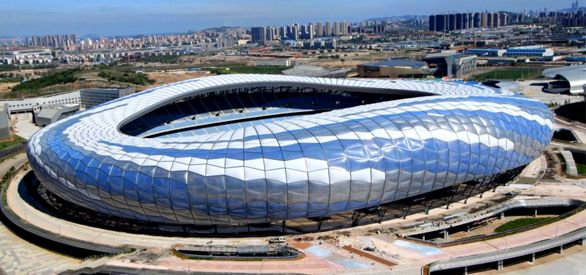
As the northern port city of Dalian was selected to host the 12th National Games, a brand new sports complex was designed in redeveloped northern district of Ganjingzi.
In a quarter created with new avenues there was enough room to accommodate a wide variety of sports facilities: the main stadium for 61,000 people, large indoor arena, two secondary athletic stadiums, two small football stadiums, baseball stadium, tennis courts and office/hotel buildings.
The stadium was designed by global architecture practice Nadel, using a popular outer form. The elliptic building is covered with 2,745 ETFE cushions, known first from stadiums created by Herzog and de Meuron, most notably the Allianz Arena.
In the case of Dalian the ETFE polymer was used in three shades, white, gray and blue. Together their layout creates a whirlpool impression by day. At night the shade difference isn’t visible any more as illumination of the cushions allows to display numerous colours on the stadium.
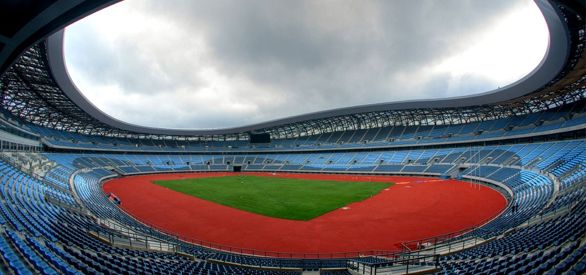
To get to the façade, spectators first enter a spacious promenade, which allows direct access to the lower of the two tiers of seating. The two-tier division isn’t as visible in the main stand, where 132 skyboxes were created. Behind them are 6 floors of space for various uses, like media, hospitality and of course the player facilities.
Having hosted the 12th National Games, the stadium may get a serious football tenant for at least some of the Super League games. The Dalian Aerbin, successor of honoured Dalian Shide, consider using the stadium for most important fixtures.
Nanchang Sports Center Stadium
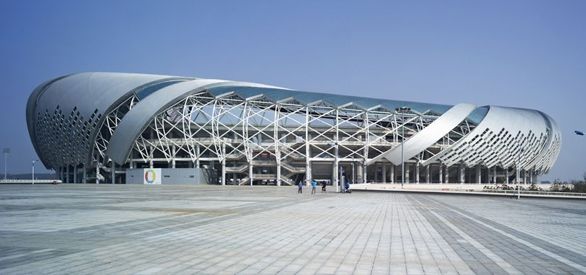
The design for Nanchang’s largest new sports complex was commissioned back in 2007. On the surface of 62 hectares, in a newly-created district along the Gan River, a new multi-sport stadium, indoor hall, swimming arena and tennis arena were built.
Initially planned to host the 7th edition of Intercity Games, the stadium received significant use also after the tournament.
Opened in 2011, the venue has dynamic architecture with external wrap imitating a vortex pattern. The colours are rather cold and sober with only one vivd accent – the additional inner ring of the roof made with red steel and carrying the floodlights. Stands accommodate some 58,000 people on three tiers.
Hohhot Stadium
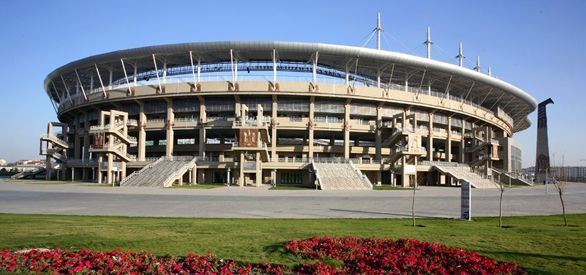
The capital of autonomous Inner Mongolia received its new stadium from the Chinese government in 2008. With little space available no sports center was created with it. The stadium alone covers a 120,000 sqm of land in northern Hohhot.
Most of the double-tiered stands are covered with polycarbonate sheets, while the exterior is very simple and frugal. With only the painted concrete and traditional sculpted decorations, the stadium’s modest appearance refers to the rough steppe climate on this highland region.
Wuhan Sports Center Stadium
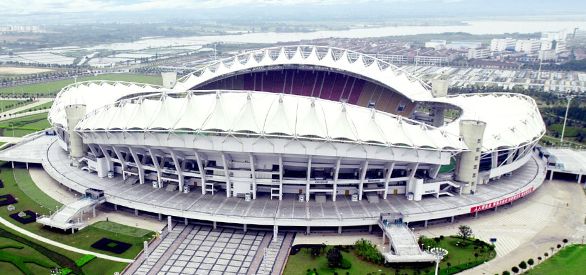
This stadium in southern Wuhan was built between 1999 and 2002 as part of one of China’s new sports centers. Announced initially to hold 60,000 people, it proved to be significantly smaller, but still sufficient for domestic football needs. Almost constantly with a league club as anchor tenant, this ground also hosted games of the 2007 Women’s World Cup.
The roof is its most distinctive part. Supported by four concrete pillars, its curved steel frames support a light membrane cover. This structure was co-created by Birdair, global leader in tensile covers.
Apart from the main stadium the complex comprises two large indoor arenas, secondary athletic stadium and two football fields. Altogether the facilities are supplied with over 3,000 parking spaces.
Huizhou Sport Center Stadium
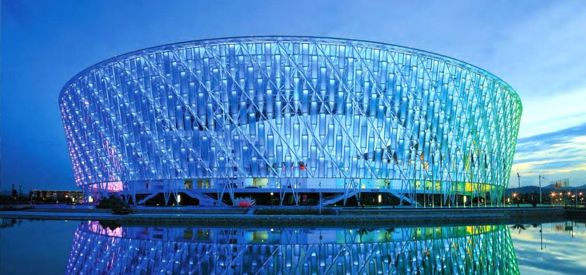
The construction of new sports complex for Huizhou was prompted by the city hosting the provincial 2009 Guangdong Games. The 36-meter tall venue is the tallest and largest building of the 500,000-sqm complex.
Its cylindrical outer form was covered with vertical blinds integrated into a diagonal steel frame. Together the elements create a light, but intricate pattern. Together with LED lighting the cladding can display various colourful images at night, while in daytime its neutral surface changes shades as sun moves.
Advertisement
 StadiumDB
StadiumDB